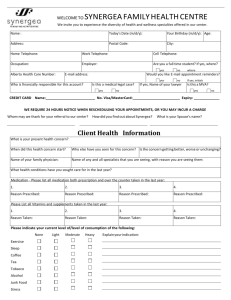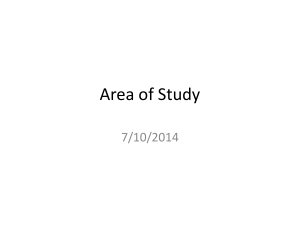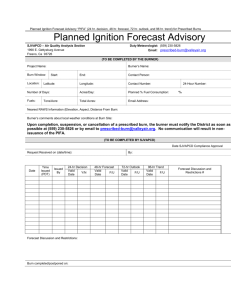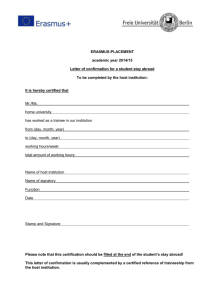prescribed burning in colorado
advertisement
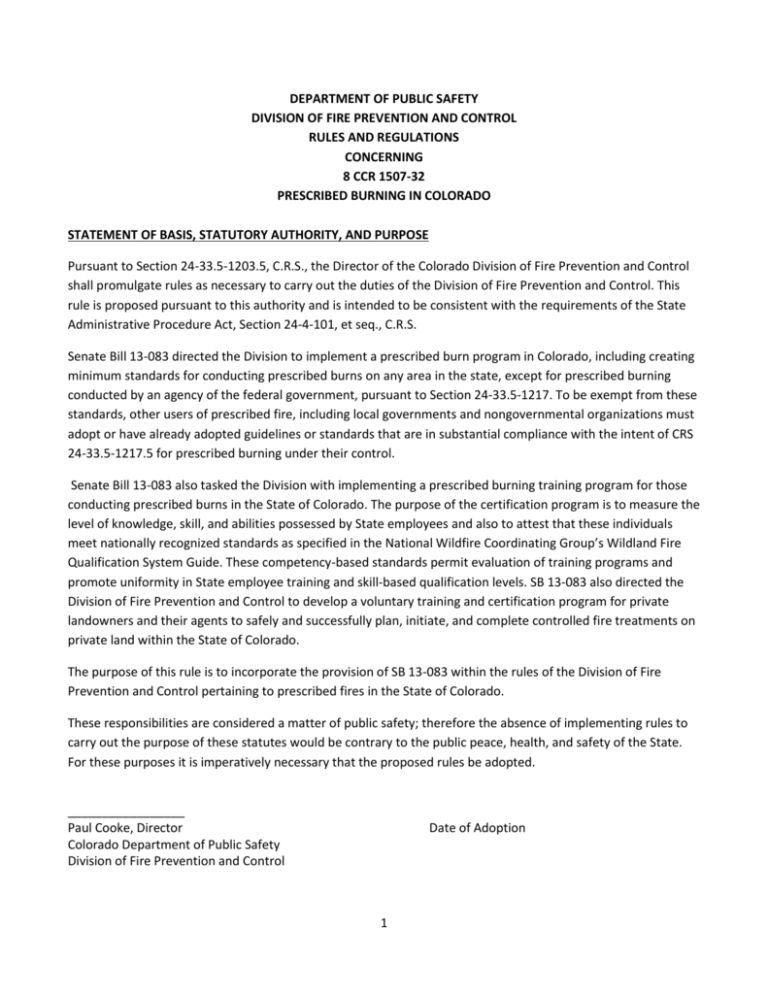
DEPARTMENT OF PUBLIC SAFETY DIVISION OF FIRE PREVENTION AND CONTROL RULES AND REGULATIONS CONCERNING 8 CCR 1507-32 PRESCRIBED BURNING IN COLORADO STATEMENT OF BASIS, STATUTORY AUTHORITY, AND PURPOSE Pursuant to Section 24-33.5-1203.5, C.R.S., the Director of the Colorado Division of Fire Prevention and Control shall promulgate rules as necessary to carry out the duties of the Division of Fire Prevention and Control. This rule is proposed pursuant to this authority and is intended to be consistent with the requirements of the State Administrative Procedure Act, Section 24-4-101, et seq., C.R.S. Senate Bill 13-083 directed the Division to implement a prescribed burn program in Colorado, including creating minimum standards for conducting prescribed burns on any area in the state, except for prescribed burning conducted by an agency of the federal government, pursuant to Section 24-33.5-1217. To be exempt from these standards, other users of prescribed fire, including local governments and nongovernmental organizations must adopt or have already adopted guidelines or standards that are in substantial compliance with the intent of CRS 24-33.5-1217.5 for prescribed burning under their control. Senate Bill 13-083 also tasked the Division with implementing a prescribed burning training program for those conducting prescribed burns in the State of Colorado. The purpose of the certification program is to measure the level of knowledge, skill, and abilities possessed by State employees and also to attest that these individuals meet nationally recognized standards as specified in the National Wildfire Coordinating Group’s Wildland Fire Qualification System Guide. These competency-based standards permit evaluation of training programs and promote uniformity in State employee training and skill-based qualification levels. SB 13-083 also directed the Division of Fire Prevention and Control to develop a voluntary training and certification program for private landowners and their agents to safely and successfully plan, initiate, and complete controlled fire treatments on private land within the State of Colorado. The purpose of this rule is to incorporate the provision of SB 13-083 within the rules of the Division of Fire Prevention and Control pertaining to prescribed fires in the State of Colorado. These responsibilities are considered a matter of public safety; therefore the absence of implementing rules to carry out the purpose of these statutes would be contrary to the public peace, health, and safety of the State. For these purposes it is imperatively necessary that the proposed rules be adopted. _________________ Paul Cooke, Director Colorado Department of Public Safety Division of Fire Prevention and Control Date of Adoption 1 DEPARTMENT OF PUBLIC SAFETY DIVISION OF FIRE PREVENTION AND CONTROL RULES AND REGULATIONS CONCERNING 8 CCR 1507-32 PRESCRIBED BURNING IN COLORADO APPLICABILITY These rules and regulations constitute the minimum standards for all prescribed burning conducted in the State of Colorado, except for prescribed burning conducted by an agency of the federal government. To be exempt from these standards, other users of prescribed fire, including local governments and nongovernmental organizations, must adopt or have already adopted guidelines or standards that are in substantial compliance with the intent of Section 24-33.5-1217.5, C.R.S. for prescribed burning under their control. These rules do not apply to controlled agricultural burning or controlled ditch burning. ARTICLE 1 – AUTHORITY TO ADOPT RULES AND REGULATIONS 1.1 The Director of the Division of Fire Prevention and Control is authorized by the provisions of Section 24-33.51203.5, C.R.S., to promulgate rules in order to carry out the duties of the Division of Fire Prevention and Control. 1.2 Sections 24-33.5-1203.5 and 24-33.5-1217, C.R.S. establish the authority and duty of the Division of Fire Prevention and Control to implement a prescribed burning program for the State of Colorado and to establish training standards for certified burners. 1.3 The Director of the Division of Fire Prevention and Control is authorized to establish fees and charges necessary to recover all direct costs that the Division incurs in providing training to and processing applications for persons seeking certification under the Prescribed Fire Program pursuant to Section 2433.5-1217. ARTICLE 2 – DEFINITIONS 2.1 The definitions provided in 24-33.5-1202, C.R.S., apply to these rules. If any of the definitions provided in these rules conflict with NWCG definitions of the same terms in the documents incorporated in Article 3, the definitions of those terms in these rules supersede the NWCG definitions. The following definitions apply: “Applicant” means a person who has satisfied the requirements to be examined for certification or an entity that applies for recognition as an accredited academy or training facility. “Burn Boss 3” means a person who has met all of the prerequisite and requisite training to be certified by his or her agency to meet NWCG qualification standards to lead low complexity prescribed burn projects. “Burn Boss 2” means a person who has met all of the prerequisite and requisite training to be certified by his or her agency to meet NWCG qualification standards to lead moderate complexity prescribed burn projects. 2 “Burn Boss 1” means a person who has met all of the prerequisite and requisite training to be certified by his or her agency to meet NWCG qualification standards to lead high complexity prescribed burn projects. “Certified Burner” means an individual who successfully completes the Division’s Certified Burner training and certification program and possesses a valid certification number. Where the term “Certified Burn Manager” is used in state statute, this term is replaced by the term Certified Burner for purposes of these rules. “Certified Proctor” means an individual who meets or exceeds the requirements to be certified as a written and/or practical examination proctor. “Class” means a single meeting or session devoted to a specific prescribed fire or non-prescribed fire training objective. “Cognitive Objective” means pertinent written questions, lists, or problems related to the level at which a person is being tested. “Course” means any grouping of classes or series of lessons or lectures combined to attain a particular education level or training objective. “Demonstrate” means to show by actual use. This may be supplemented by, or when actual use is not feasible, replaced by, simulation, explanation, illustration, or a combination of these methods. “Director” means the Director of the Division of Fire Prevention and Control in the Department of Public Safety. “Division” or “DFPC” means the Division of Fire Prevention and Control in the Department of Public Safety. “Fire department” means the duly authorized fire protection organization of a town, city, county, or city and county, a fire protection district, or a metropolitan district or county improvement district that provides fire protection. “Firefighter” means any person, whether paid or volunteer, who is actively participating in or employed by a public or private fire service unit in this state. “High Complexity Burn” means a burn classified as high complexity by NWCG’s Prescribed Fire Complexity Rating System Guide based on risk, potential consequences, and technical difficulty. “Low Complexity Burn” means a burn classified as low complexity by NWCG’s Prescribed Fire Complexity Rating System Guide based on risk, potential consequences, and technical difficulty. "Masticated Fuels" means fuels, such as brush, small-diameter trees, and slash, that have been ground or chewed into small pieces of woody material through a mechanical wildland fuels treatment process, and generally left to carpet the ground. “Moderate Complexity Burn” means a burn classified as moderate complexity by NWCG’s Prescribed Fire Complexity Rating System Guide based on risk, potential consequences, and technical difficulty. 3 “National Wildfire Coordinating Group” or “NWCG” means the nationally recognized group made up of federal and state cooperating agencies which governs nationally based training and qualification standards for wildland fire, including prescribed fire. NWCG also includes subcommittees and working teams governed by NWCG directors. “Non-certified” means an applicant who does not possess a valid certification recognized by DFPC. “Physical Demand” means the work capacity levels that are assigned to all wildland fire management positions to quantify physical fitness for a specified position. The various levels are measured over a specific distance, with a defined cargo load and efficiently accomplished within a specified time limit and in accordance with procedures and standards established by the NWCG. “Policies” means formal guidelines promulgated by DPFC concerning the methods, procedures, and processes for implementing these rules and administering any certification program. “Prescribed Burning” or “Prescribed Fire” means the application of fire, in accordance with a written prescription for vegetative fuels, under specified environmental conditions while following appropriate precautionary measures that ensure public safety and that is confined to a predetermined area to accomplish public safety or land management objectives. The term excludes controlled agricultural burns and controlled ditch burns as defined in CRS 24-33.5-1201. “Prescribed Fire Manager Type 2” or “RXM2” means a person who has met all of the prerequisite and requisite training to be certified by his or her agency to meet NWCG qualification standards to lead moderate complexity prescribed burn projects. “Prescribed Fire Manager Type 1” or “RXM1” means a person who has met all of the prerequisite and requisite training to be certified by his or her agency to meet NWCG qualification standards to lead high complexity prescribed burn projects. “Refresher training” means a course of instruction, condensed over a short period of time, designed to provide training to persons for the purpose of preparing them for renewal of certification. “Safely” means to perform the objective without endangering or injuring oneself or others. “State agency” means all of the departments, divisions, commissions, boards, bureaus, and institutions in the executive branch of state government. “State agency” does not include the legislative or judicial department, the department of law, the department of state, the department of the treasury, or state-supported institutions of higher education. “With competence” means possessing knowledge, training, skills, and judgment needed to satisfactorily and safely perform indicated objectives, as determined by the examining authority. ARTICLE 3 – GUIDES, DOCUMENTS, AND STANDARDS INCORPORATED BY REFERENCE 3.1 The following guides and standards are adopted by these regulations. The following standards are published by the National Wildfire Coordinating Group, National Interagency Fire Center, Boise, ID 83705. Copies of these 4 guides and standards can be obtained from the National Wildfire Coordinating Group via the Great Basin Cache Supply Office, 3833 S. Development Ave. Boise, ID 83705 or via www.nwcg.gov. 3.1.1 Interagency Standards for Fire and Aviation Operations (January 2013) NFES 2724 3.1.2 Prescribed Fire Complexity Rating System Guide (January 2004) PMS 424, NFES 2474 3.1.3 Interagency Prescribed Fire Planning and Implementation Procedures Guide (July 2008) 3.1.4 Fire Effects Guide (June 2001) NFES 2394 3.1.5 Wildland Fire Qualification System Guide (October 2013) PMS 310-1 3.1.6 NWCG Glossary of Wildland Fire Terminology (July 2012) PMS 205 3.2 The following policy is adopted by these regulations. The following policy is published by the Colorado Division of Fire Prevention and Control. Copies of this policy can be obtained at 690 Kipling Street, Denver, CO 80215 or online at www.dfs.state.co.us. 3.2.1 Colorado State Prescribed Fire Planning and Implementation Policy Guide (January 2014) 3.3 The Division shall maintain copies of the complete texts of the adopted guides and standards for public inspection. Interested parties may inspect the referenced incorporated materials during regular business hours at the Division Office located at 690 Kipling St, Lakewood, CO 80215. 3.4 This rule does not include later amendments or editions of the incorporated material. 3.5 Questions, clarifications, or interpretation of any guidelines, policy, procedure, or standard adopted by reference in these rules should be addressed in writing to: Prescribed Fire Program Manager/Branch Chief, Colorado Division of Fire Prevention and Control, 690 Kipling St, Lakewood, CO 80215. ARTICLE 4 – TYPES OF CERTIFICATION, FEES, AND APPLICATION REQUIREMENTS 4.1 The following prescribed fire certifications are available through the Division: 4.1.1 Certified Burner 4.1.2 Burn Boss Type 3-RXB3 4.2 The Division recognizes NWCG certifications that relate to prescribed fire as referenced in the Wildland Fire Qualification System Guide and the Interagency Prescribed Fire Planning and Implementation Guide referenced in Article 3. 4.3 Certified Burner Program 4.3.1 Application Requirements 5 a) Certified Burner Course. Members of the public must sign up for this course through the vendor or institution providing the course on behalf of the Division. Information regarding upcoming courses can be obtained by contacting the Prescribed Burn Manager at the Division. b) Application for Certification. After an applicant has completed the Certified Burner course, final exam, and related task book, he or she must send the completed task book and the fees outlined in 4.3.3 to the Certification Manager at the Division in order to obtain certification and a certification number. 4.3.2 Training Components. a) The Certified Burner Course is a 32-hour course over four days. The Certified Burner Course will cover the following information on prescribed fire: 1) Basic Fire Behavior 2) Introduction to Prescribed Burning 3) Legal Aspects of Prescribed Burning 4) Developing a Prescribed Burn Plan 5) Smoke Management 6) Prescribed Burning Exercise b) At the end of the course, the instructor will administer a final exam. Prospective Certified Burners who have taken the course and passed the exam with a score of 70% or higher will be issued a task book that must be completed within three years of the exam date in order to obtain certification as a Certified Burner. c) Prospective Certified Burners who score below 70% on the final exam may retake the exam two times without retaking the entire course. A minimum thirty (30) day waiting period is required between examination attempts. Prospective Certified Burners who score below 70% on the final exam after three tries will be required to retake the Certified Burner Course and pass the final exam in order to obtain a task book and certification. d) After successful completion of the certified burner course and final exam, students will receive a task book which requires certain tasks to be performed in a suitable manner under the supervision of the Division or a designated agent. The task book identifies specific tasks that need to be evaluated, verified, initialed, and dated by the Division or a designated agent for each specific burn project. These multiple tasks evaluate the trainee’s performance and identify any deficiencies that may require additional project assignments to complete. At the point when all tasks have been satisfactorily completed, the task book must be submitted to the Division with the application fee and any supporting documents in order for an applicant to obtain certification. 6 4.3.3 Terms and Duration of Certification a) Certificates expire on January 1 of the fifth year following issuance. For example, a certificate issued on January 10, 2014 will expire on January 1, 2019. b) By issuing a Certified Burner certification number, the Division is verifying that an individual has successfully completed the Certified Burner Course and task book and is qualified to perform low complexity prescribed burns as defined by NWCG’s Prescribed Fire Complexity Rating System Guide adopted by reference in Section 3.1.2. c) Certified Burners must complete at least two separate prescribed fire projects to be eligible for certification renewal at the expiration of their certification. At the time of certification expiration, documentation of this minimum requirement must accompany the renewal application and payment of the renewal fee. d) If a Certified Burner does not renew his or her certification within 90 days of expiration or if the Certified Burner has not completed the required amount of prescribed burns during his or her certification, then he or she must retake the Certified Burner Course and complete the associated task book again to obtain certification. 4.3.4 Fees Certified Burner Course* Application Fee for Certified Burner Certification Renewal Fee for Certified Burner Certification prior to expiration Reinstatement Fee for Certified Burner Certification fewer than 90 days past expiration $200 - $500 (varies based on host location) $30.00 $20.00 $40.00 *Note: To the extent that grant funds are available, these courses may be provided at no or significantly lower cost to the participant. 4.4 Burn Boss Type 3 – RXB3 4.4.1 Application Requirements a) Applicants must sign up for this course through the vendor or institution providing the course on behalf of the Division. Information regarding upcoming courses can be obtained by contacting the Prescribed Burn Manager at the Division. b) Applicants for the Burn Boss Type 3 Certification must possess the following NWCG qualifications: 1) Required Training: Intermediate Wildland Fire Behavior (S-290) 7 2) Required Experience: i) Satisfactory Performance as an Incident Commander, Type 5 (ICT5); or ii) Firefighter Type 1 (FFT1) and Successful position performance as a Prescribed Fire Burn Boss Type 3 (RXB3) 3) Physical Fitness Level - Arduous 4.4.2 Training Components a) The Burn Boss Type 3 Course is the same 32-hour course over four days as the Certified Burner Course. The Course will cover the following information on prescribed fire: 1) Basic Fire Behavior 2) Introduction to Prescribed Burning 3) Legal Aspects of Prescribed Burning 4) Developing a Prescribed Burn Plan 5) Smoke Management 6) Prescribed Burning Exercise 4.4.3 Fees Burn Boss Type 3 Course $200 - $500 (varies based on host location) 4.4.4 Certification/Credentials Received. An applicant for RXB3 who successfully completes the course, exam, and task book must be certified by his or her sponsoring agency. The Division will certify RXB3 applicants who are employed by the Division and may certify employees from other state agencies with an interagency agreement. ARTICLE 5 – GROUNDS AND PROCESSES FOR RENEWAL, SUSPENSION, AND REVOCATION OF CERTIFICATIONS 5.1 The Division, in accordance with the Administrative Procedures Act, C.R.S. 24-4-101, et seq., may deny or revoke any certificate or refuse to renew a certificate to any applicant for, but not limited to, the following reasons: 5.1.1 Failure to meet requirements specified in these rules pertaining to the issuance of certificates and/or the renewal of certification 5.1.2 Any conduct as described in Section 5.2 pertaining to good cause for disciplinary action 8 5.1.3 Fraud, misrepresentation, or deception in applying for or securing certification. Or in taking any written or practical certification exam 5.1.4 Aiding and abetting another person in procuring or attempting to procure certification for any person who is not eligible for certification 5.1.5 Creating a disturbance during a state practical skills evaluation or a state written examination, or conducting themselves in a manner that disrupts other persons taking the examination or prevents the examination proctor from conducting the examination. 5.2 In addition to the reasons outlined in 5.1, the Division may revoke an individual’s Certified Burner certification if the individual is assessed fifteen (15) points as outlined in 5.2.1 during the course of any one certification period. 5.2.1 Violation Point Assessment Table Certified Burner initiates a burn outside of prescription parameters based upon morning forecast Certified Burner obtains an authorization knowingly using false information Fire escapes from the prescribed area and does not cause damage to the property of the Certified Burner or landowner An emergency response agency is required to take suppression actions because of a burn led by Certified Burner. Certified Burner fails to pay suppression charges on an escaped burn within 15 days of receipt of second notice Certified Burner fails to identify or mitigate smoke sensitive areas Certified Burner burns without obtaining an authorization Certified Burner fails to attempt to shut down a burn after notification from the Division or Colorado Air Pollution Control Division Certified Burner’s escaped fire causes damage to the property/improvements of persons other than the Certified Burner Certified Burner attempts to burn as a Certified Burner without a written prescription at the site of the burn while burn is being conducted Five (5) Points Fifteen (15) Points Three (3) Points Two (2) Points Three (3) Points Two (2) Points Fifteen (15) Points Five (5) Points Five (5) Points Five (5) Points 5.2.2 The Division will discover potential violations through direct investigation or from information provided by local or state agencies or the general public. The Division will investigate all allegations of a Certified Burner committing one of the violations in 5.2.1. Following a determination that a violation has been committed, the Division will send a written notice of violation to the Certified Burner’s address on file with the Division. Upon receipt of the notification, a Certified Burner then has thirty (30) days to respond in writing to contest the notice of violation. The protest may include any relevant information or documentation as to why the points should not be assessed against the Certified Burner. 9 5.2.3 Once the Division receives a Certified Burner’s contest of a violation notice, the Division Director shall determine whether points should be assessed against the Certified Burner and notify the Certified Burner of his or her decision in writing within thirty days of receipt of a Certified Burner’s contest of a violation notice. This decision shall be considered a final agency action for the purposes of the Colorado Administrative Procedure Act, 24-4-101, et seq., C.R.S. 5.2.4 If a Certified Burner accumulates 15 points during one certification period, the Division will send a notice of decertification to the violator. The Certified Burner has 30 days from the date the notice of decertification is issued to protest the decertification notice to the Division Director. The Division Director shall notify the Certified Burner of his or her decision on the Certified Burner’s decertification within 30 days of receipt of a Certified Burner’s protest of a decertification notice. This decision shall be considered a final agency action for purposes of the Colorado Administrative Procedure Act, 24-4-101, et seq., C.R.S. 5.2.5 Once decertified, an individual must complete the Certified Burner Course and the requisite training task book in order to be recertified as a Certified Burner. ARTICLE 6: PRESCRIBED FIRE POLICY 6.1 The rules and standards provided in this Article 6 govern prescribed burning occurring on state lands or conducted by state agencies on private lands. 6.2 The Division adopts the Colorado State Prescribed Fire Planning and Implementation Policy Guide as referenced in Section 3.2.1 as the minimum standard for prescribed fire planning and implementation for Colorado state agencies and for prescribed burns conducted on state lands in Colorado. 6.3 Prescribed Fire Plans. 6.3.1 Prescribed fire plans developed before the effective date of these rules must receive a technical review in order to ensure compliance with the 2014 Colorado State Prescribed Fire Planning and Implementation Policy Guide before the plan can be implemented. 6.3.2 Prescribed fire plans developed after the effective date of these rules must receive an additional technical review after three years if the plan is not implemented. 6.3.3 Prescribed fire plans expire five years after their approval date and must be rewritten to ensure compliance with new or modified policies or environmental changes. ARTICLE 7: SEVERABILITY 7.1 If any provision or application of these rules is held invalid, all other provisions and applications of these rules will remain in effect. 10 ARTICLE 8: INQUIRIES 8.1 All questions or requests for interpretation of these rules should be submitted in writing to the Colorado Division of Fire Prevention and Control, Prescribed Fire Manager. 11


